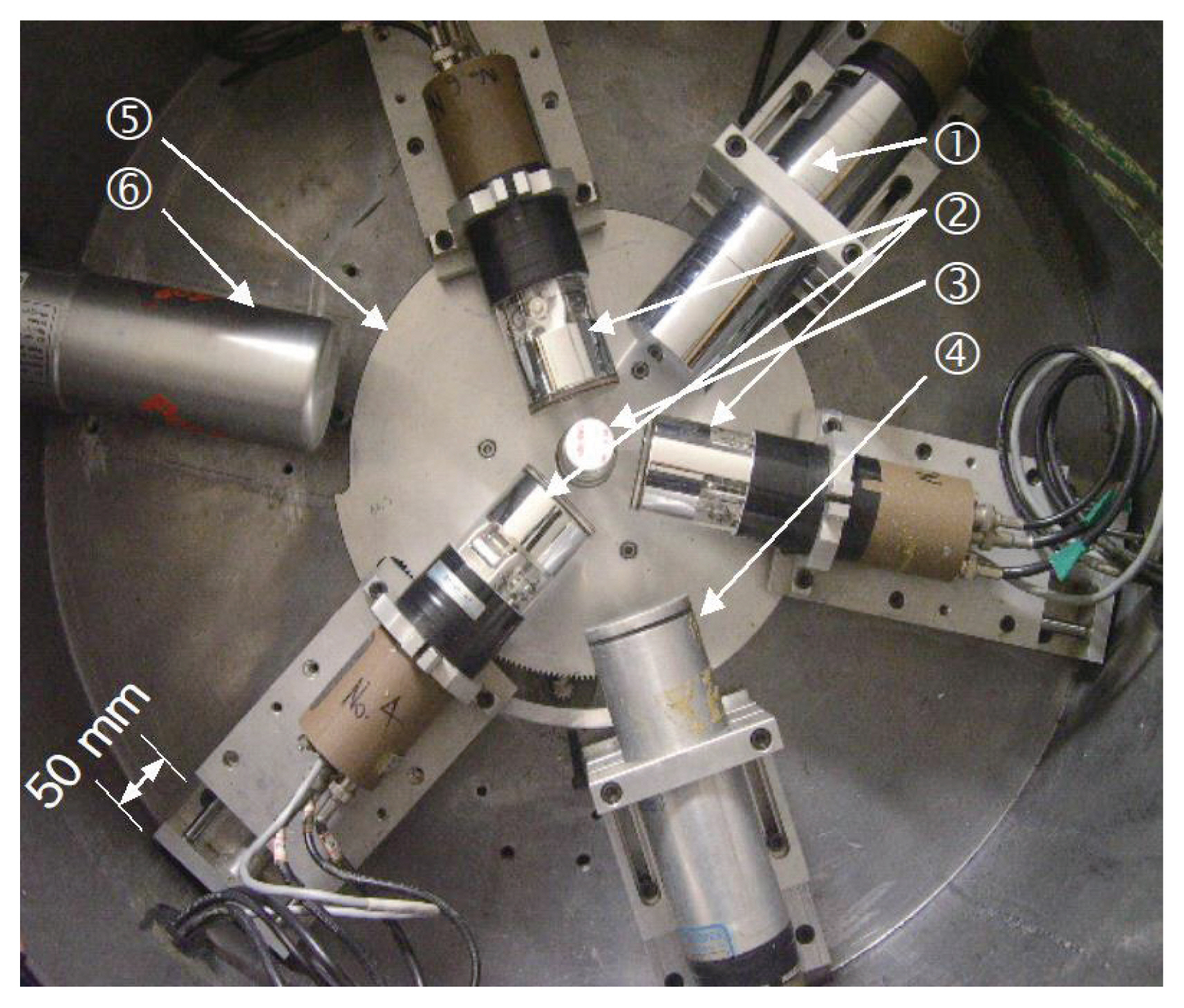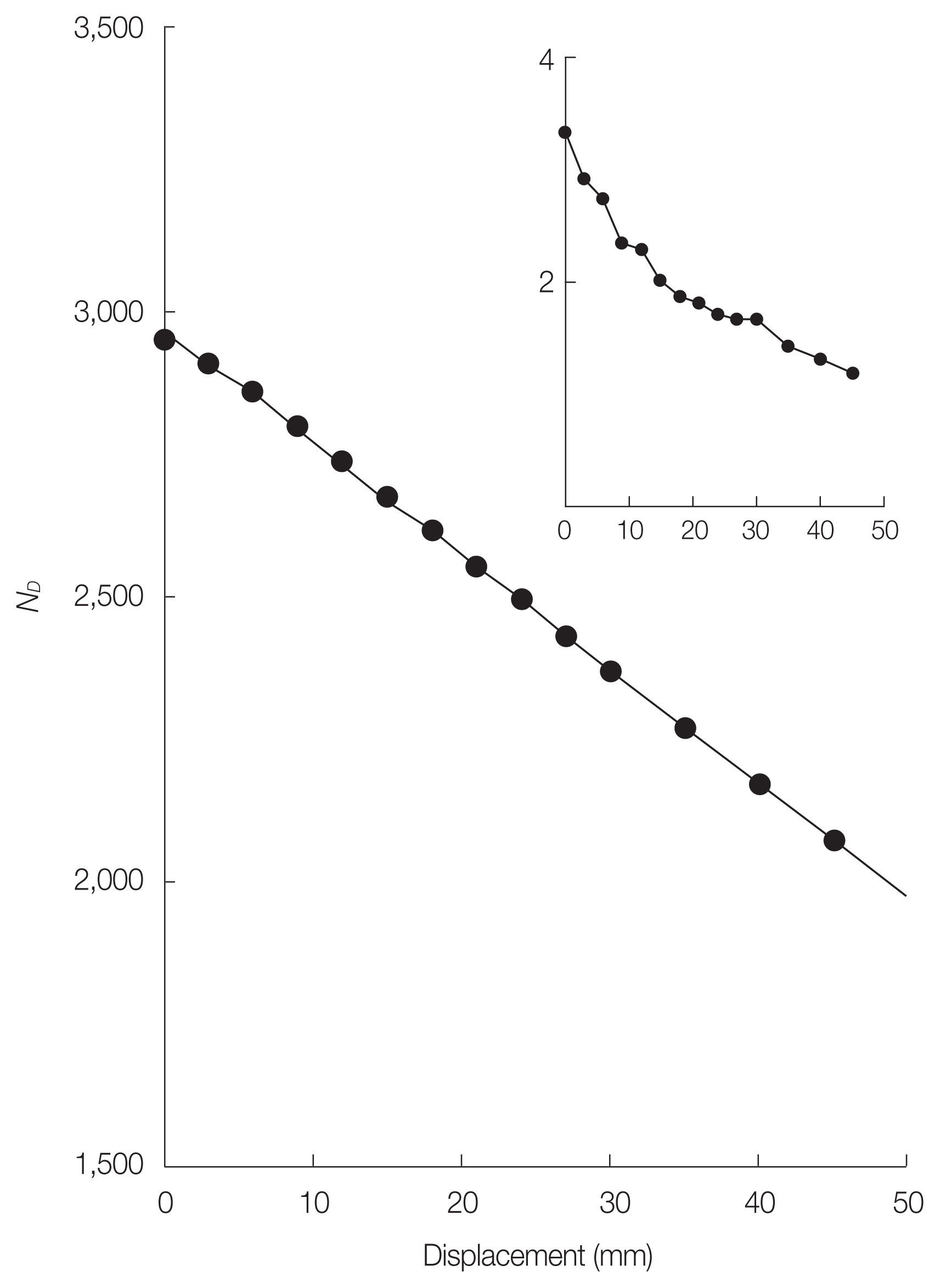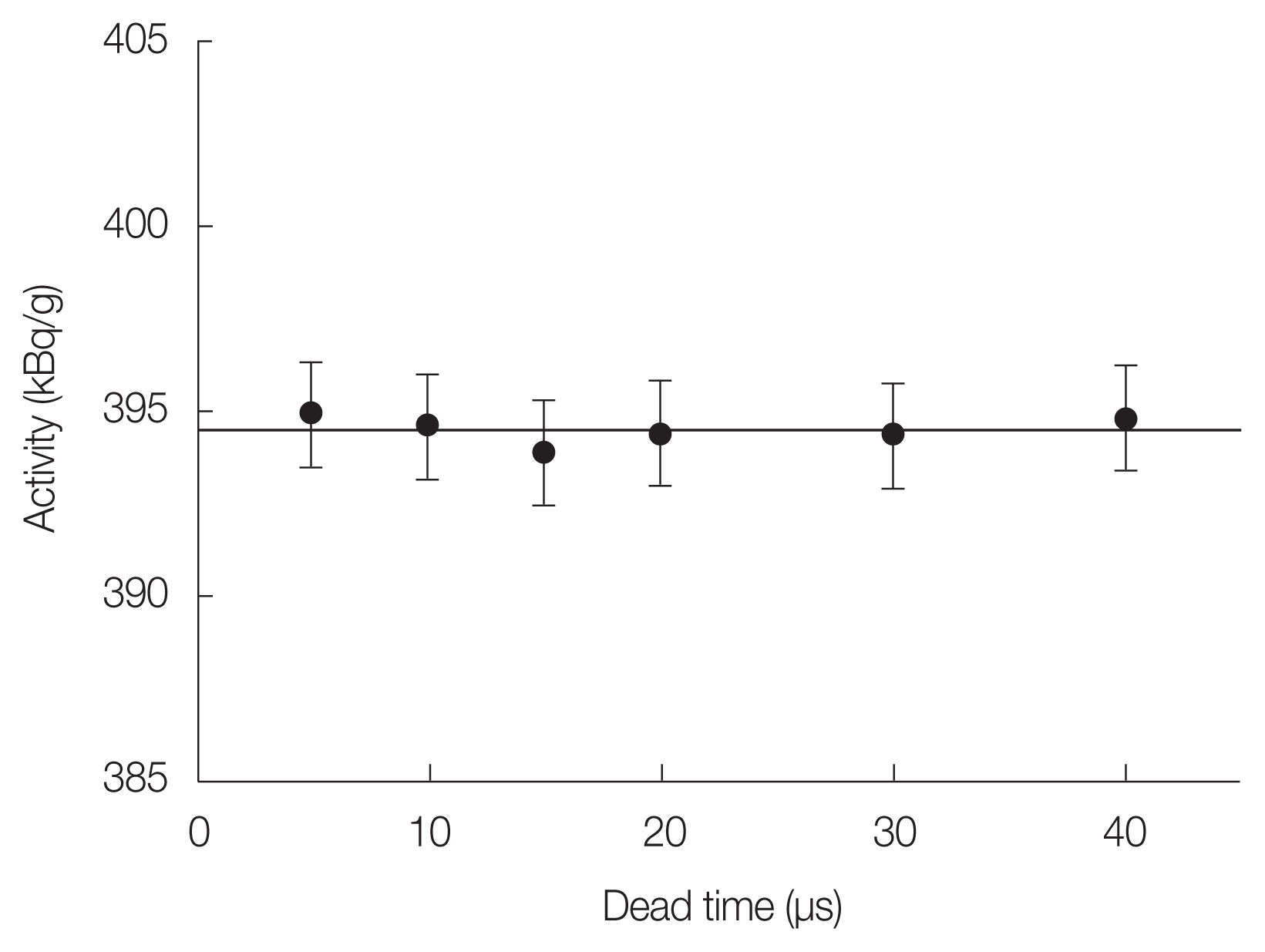Introduction
We have been successfully developing a movable 3 photomultiplier (3PM)-╬│ device, based on 4ŽĆ(liquid scintillator [LS])╬▓-╬│ (NaI(Tl)) coincidence counting method, for activity standardization of pure ╬▓- or ╬▓-╬│ emitters [1, 2]. The three PM tubes placed on the plane are movable from a liquid scintillation vial at the same time, thus enabling the variation of ╬▓-detection efficiencies by a geometrical technique to apply the efficiency-extrapolation method. The results obtained with the method were consistent with the ones determined by conventional liquid scintillation counting or 4ŽĆ(proportional counter [PC])╬▓-╬│(NaI(Tl)) coincidence counting. However, for the case of ╬▓-╬│ emitters, ╬▓-event was determined from linear sum of dynode output signal of each PM tube in our earlier work (see Fig. 2 in reference [2]), thus the background caused by thermal noises or after-pulse could be counted. It was a major factor to overcome in improving measurement accuracy according to our previous work.
Recently, the triple to double coincidence ratio (TDCR) method based on a three PM detection system for liquid scintillation counting [3ŌĆō5] has been extended to 4ŽĆ(LS)╬▓-╬│ coincidence counting [6ŌĆō8]. Since the thermal noise and the after-pulses detected in each PM tube are in uncorrelated relation each other, thus expected to remove them from the coincidence channel. With this fact, we have planned to improve a movable 3PM-╬│ coincidence counting device by applying TDCR technique, namely the ╬▓-event is determined from the logical sum of three double coincidences. Thus, it is expected to reject thermal noises or after-pulses by the coincidence channels.
The objectives of this study are to show that the method developed through this work can be of an alternative technique suitable for activity standardization of ╬▓-╬│ emitters. For this, it should investigate the stability of the method against the change of measurement conditions arising from the duration of dead times or thermal noises or after-pulses. So the activity-fluctuations due to above mentioned factors were carefully investigated by varying the duration of dead-times from 5 ╬╝s to 40 ╬╝s. The validity of the method has been demonstrated through the activity standardization of 134Cs calibrated at the Korea Research Institute of Standards and Science (KRISS) by 4ŽĆ(PC)╬▓-╬│ coincidence method using proportional counter for ╬▓-detector.
The design of the movable 3PM-╬│ apparatus, logic signal analyzer and data acquisition device developed for this work are in the following section.
Materials and Methods
1. Movable 3PM-╬│ Apparatus Installed at Mokwon University
The detection unit of 3PM-╬│ coincidence system installed at Mokwon University is shown in Fig. 1. Three photo-detectors used for ╬▓-detectors are the PM tubes of Hamamatsu R1847-07 with bi-alkali photocathode of 51 mm in diameter. These ╬▓-detectors in the plane were designed to move back and forth from centrally located liquid scintillation vial by a connecting gear. A vise ties up them to move at a same time manually up to 50 mm by rotating a saw-toothed gear. Another three photon detectors, NaI(Tl), HPGe, and X-ray detector, are located 120 mm rear from the front of ╬▓-detectors not to screen the scintillation pulses incident on the windows. In the present work, a NaI(Tl) detector, 254 mm (long)├Ś251 mm (diameter) was used in the ╬│-counting channel. Detection unit is located in a cylindrical chamber of 650 mm in inner diameter and 320 mm high and the outer wall is shielded by a 20-mm thick lead plate.
2. Data Acquisition Method
The dynode outputs of each PM tube in the ╬▓-channel is amplified and converted to a positive transistor-transistor logic (TTL) signal with 500 ns width at single channel analyzer (SCA). Thermal noises could be rejected at coincidence channels, so the threshold level of each ╬│-counting channel was lowest level +60 mV of applied SCA. Three double coincident events from these signals are analyzed and their logical sum ND is obtained (ND becomes ╬▓-events). The resolving time was 500 ns, the width of the SCA output signal. Both the SCA output N╬│ from ╬│-channel and the ND are input to Pulse Gate, custom-made at the factory for this work. It was fabricated in an integrated circuit so that it not only adjusts the delay time and pulse width of each output pulse, but also has the ability to do AND/OR works. All operations are controlled by the RSC 232 serial communication port. Delay time and pulse width, whichever is longer, becomes the dead time of corresponding counting channel. It is non-extending type. Outputs from Pulse Gate, ND, N╬│ and coincidence counting ND╬│, are recorded in Data Acquisition device. The simplified block diagram of the applied electronics is displayed Fig. 2. The modules laying inside rectangular box are logic signal analyzers specially designed for this work.
3. Sample Preparation
Liquid scintillation samples were prepared by mixing aliquots of a radioactive solution of 134Cs with 10 mL liquid scintillator. It was same one used at our earlier work [2]. This radionuclide is very important for calibration of ╬│-ray spectrometry and also used as a tracer for 137Cs activity determination [9, 10]. It decays mainly by ╬▓-emission to 134Ba. In the de-excitation process, 11 ╬│-emissions are identified [11]. The coincidence window was set on 796 keV full-energy peak. The liquid scintillation samples were prepared by filling 20 mL standard glass vials with 10 mL of unquenched Ultima Gold liquid scintillator (PerkinElmer, Waltham, MA, USA). The observed counting rates were from 3├Ś103 sŌłÆ1 to 6├Ś103 sŌłÆ1. The measurement was carried out for 14 counting intervals for each prepared sample by displacing three PM tubes up to 45 mm from a counting sample, up to 30 mm in steps of 3 mm and then to 45 mm in steps of 5 mm. Backgrounds were measured likewise.
Results and Discussion
1. Validation of Geometrial Efficiency Variation Method
Fig. 3 shows logical sums of three double coincidences rate (ND) observed at each counting interval with a sample. As the ╬▓-detection unit, three PM tubes, was moving away from a centrally located counting vial, it was decreasing absolutely up to 30% according to our data, thus expecting to obtain the efficiency function defined on a sufficient region to extrapolate linearly. Inset shows observed background versus displacement. It was about 3.3 sŌłÆ1 to 1.2 sŌłÆ1 for every cases of measurement. For the case of a sample of count rate of 3,000 sŌłÆ1, effects of background on observed activity is about 0.08% according to data. It was 0.57% with our earlier method (Table 1), so it was a major factor in reducing measurement accuracy. However, we could confirm the backgrounds due to thermal noises or after-pulses were almost rejected at coincidence channel to negligible levels.
2. Linear Extrapolation of Efficiency Function
The dead time of each ╬▓- and ╬│-counting channel was adjusted to be non-extending type of 20 ╬╝s (see next paragraph). The true coincidence rate Žü╬▓╬│, true ╬▓ count rate Žü╬▓ (=ND), true ╬│ count rate Žü╬│ and ╬▓-detection efficiency ╔ø╬▓ (=Žü╬▓╬│/Žü╬│) were corrected and determined by using the mathematical formula derived by Cox and Isham [12], and completed by Smith [13].
Fig. 4 shows a plot of an efficiency function obtained at each counting interval. The parameter of x-axis is (1ŌłÆ╔ø╬▓)/╔ø╬▓ and y-axis is ND/(╔ø╬▓├Śm) where m is the mass of a considering sample. The observed values of ╬▓-detection efficiency ╔ø╬▓ were 0.54Ōēż╔ø╬▓Ōēż0.81. The ND/(╔ø╬▓├Śm) were varying linearly on the whole counting interval, thus could be linearly extrapolated to (1ŌłÆ╔ø╬▓)/╔ø╬▓=0, so ╔ø╬▓=1, by the least-squares method for a plot of ND/(╔ø╬▓├Śm) versus (1ŌłÆ╔ø╬▓)/╔ø╬▓. The average of the weighted mean value is 396.3┬▒1.7 kBq/g (Table 1), at reference date. The uncertainty was calculated from the square root of the summed squares of each uncertainty component as shown in Table 1. The largest uncertainty component was due to the curve fitting. The KRISS certified value is 396.0┬▒2.0 kBq/g. It is consistent with ours within uncertainty limit.
3. Selection of the Duration of Dead Time
Concerning the duration of dead-time, it usually applies long length of extending type, for example 30 ╬╝s or more, to reject the after-pulses with conventional TDCR method [3ŌĆō5]. Since we have applied non-extending type for all ╬▓- and ╬│-counting channels, it was necessary to determine the appropriate width of dead-time and also to investigate the effects of after-pulses or other factors on measured values. For this, activity-deviations due to the duration of dead time were observed with non-extendable width varying from 5 ╬╝s to 40 ╬╝s. All measurement cases were performed as described above. To see it more clearly, it has been done with a sample with relatively high counting rate of 6├Ś103 sŌłÆ1.
The results obtained from each selected width (Fig. 5), were uniformly distributed around the value at 20 ╬╝s. The biggest difference was observed between the data of 5 ╬╝s and of 15 ╬╝s and it was 0.26% at most. In fact, any notable effects due to after-pulses or other factors on activity determinations could not be found according to our data. So, it was adjusted to be 20 ╬╝s of non-extending type with a standard uncertainty of 0.05% for our system.
Conclusion
We have successfully improved a movable 3PM-╬│ coincidence counting method by using the logical sum of three double coincidences for ╬▓-event. Background due to thermal noises or after-pulses could be reduced to negligible levels. In fact, compared to our earlier work, the measurement accuracy has been much improved.
In addition, there are several positive attributes with liquid scintillation counting such as simple sample preparation, high counting efficiency and the absence of self-absorption. However, to induce efficiency variations with conventional method, either high voltage or SCA adjustment or several quenched material should be prepared. These tasks are not only cumbersome but can also be a source of error. On the other hand, the method developed through this study shows that the efficiency function can be derived by changing the distance between the detector and the sample simply. Not only the measurement conditions are unchanged except the distance but the operation is very easy and fast. The result obtained with the method is well consistent with the KRISS calibrated value.
Consequently, the method developed through this study can be of a suitable technique for activity standardization of ╬▓-╬│ emitters.










